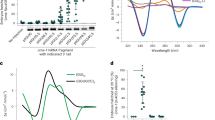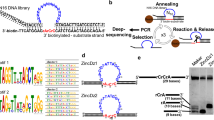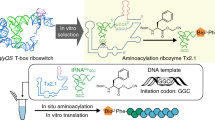Abstract
A minizyme is a hammerhead ribozyme with a short oligonucleotide linker instead of stem/loop II. Minizymes with low activity as monomers form active dimeric structures with a common stem. We explored the use of dimeric minizymes as gene-inactivating agents by placing minizymes under the control of a tRNAVal promoter. The tRNA1Val portion of the transcript did not hinder dimerization as the tRNA-embed-ded minizyme formed an active dimeric structure. The cleavage activity of this minizyme that had been expressed either in vitro or in HeLa cells was almost one order of magnitude higher than that of the tRNAVal-embedded conventional hammerhead ribozyme. The tRNAVal-driven minizyme inhibited reporter gene activity (95%) whereas the tRNAVal-driven hammerhead ribozyme resulted in approximately 55% inhibition
This is a preview of subscription content, access via your institution
Access options
Subscribe to this journal
Receive 12 print issues and online access
$209.00 per year
only $17.42 per issue
Buy this article
- Purchase on Springer Link
- Instant access to full article PDF
Prices may be subject to local taxes which are calculated during checkout
Similar content being viewed by others
References
Symons,R.H. 1989. Self-cleavage of RNA in the replication of small pathogens of plants and animals. Trends Biochem. Sci. 14: 445–450.
Kazakov,S. and Altman,S. . 1992. A trinucleotide can promote metal ion-dependent specific cleavage of RNA. Proc. Natl. Acad. Sci. USA 89: 7939–7943.
Picirilli,J.A., Vyle,J.S., Caruthers,M.H.,and Cech,T.R. 1993. Metal ion catalysis in the Tetrahymena ribozyme reaction. Nature 361: 85–88.
Dahm,S.C., Derrick,W.B., and Uhlenbeck,O.C. . 1993. Role of divalent metal ions in the hammerhead RNA cleavage reaction. Biochemistry 30: 9464–9469.
Steitz,T.A. and Steitz,J.A. 1993. A general twometal-ion mechanism for catalytic RNA. Proc. Watt Acad. Sci. USA 90: 6498–6502.
Eckstein,R. and Lilley,D.M.J. (eds.). (eds). 1996. Catalytic RNA nucleic acids and molecular biology. Vol. 10. Springer-Verlag Press, Berlin, Germany
Weinstein,L.B., Jones,B.C., Cosstick,R., and Cech,T.R. 1997. A second catalytic metal ion on group I ribozyme. Nature 388: 805–808.
Sawata,S., Komiyama,M., and Taira,K. 1995. Kinetic evidence based on solvent isotope effects for the nonexistence of a proton-transfer process in reactions catalyzed by a hammerhead ribozyme: implication to the double-metal-ion mechanism of catalysis. J. Am. Chem. Soc. 117: 2357–2358.
Zhou,D.-M., Zhang,L.-H.,and Taira,K. 1997. Explanation by the double-metal-ion mechanism of catalysis for the differential metal ion-effects on the cleavage rates of 5′-oxy and 5-thio substrates by a hammerhead ribozyme. Proc. Watt Acad. Sci. USA 94: 14343–14348.
Lott,W.B., Pontius,B.W., and von Hippel,P.H. 1998. A two metal ion mechanism operates in the hammerhead ribozyme-mediated cleavage of an RNA substrate. Proc. Watt Acad. Sci. USA 95: 542–547.
Zhou,D.-M., and Taira,K. 1998. The hydrolysis of RNA: from theoretical calculations to the hammerhead ribozyme-mediated cleavage of RNA. Chem. Rev. 98: 991–1026.
Pley,H.W., Flaherty,K.M., and Mackay,D.B. 1994. Three-dimensional structure of a hammerhead ribozyme. Wafure 372: 68–74.
Scott,W.G., Finch,J.T., and Klug,A. 1995. The crystal structure of an all-RNA hammerhead ribozyme: a proposed mechanism for RNA catalytic cleavage. Cell 81: 991–1002.
Scott,W.G., Murray,J.B., Arnold,J.R.P., Stoddard,B.L., and Klug,A. 1996. Capturing the structure of a catalytic RNA intermediate: the hammerhead ribozyme. Science 274: 2065–2069.
McCall,M.J., Hendry,P., and Jennings,PA. 1992. Minimal sequence requirements for ribozyme activity. Proc. Natl.Acad. Sci. USA 89: 5710–5714.
Tuschl,T. and Eckstein,F. 1993. Hammerhead ribozymes:importance of stem-loop II activity. Proc. Watt Acad. Sci. USA 90: 6991–6994.
Fu,D.J., Benseler,F. and Mclaughlin,L.W. 1994. Hammerhead ribozymes containing non-nucleoside linkers are active RNA catalysts. J. Am. Chem. Soc. 116: 4591–4598.
Long,D.M. and Uhlenbeck,O.C. 1994. Kinetic characterization of intramolecular and intermolecular hammerhead RNAs with stem II deletions. Proc. Natl. Acad. Sci. USA 91: 6977–6981.
Amontov,S. and Taira,K. 1996. Hammerhead minizymes with high cleavage activity a dimeric structure as the active conformation of minizymes. J. Am. Chem. Soc. 118: 1624–1628.
Kuwabara,T., Amontov,S., Warashina,M., Ohkawa,J., and Taira,K. 1996. Characterization of several kinds of dimer minizyme: simultaneous cleavage at two sites in HIV-1 tat mRNA by dimer minizymes. Nucleic Acids Res. 24: 2302–2310.
Geiduschek,E.P. and Tocchini-Valentini,G.P. 1988. Transcription by RNA poly-merase III. Annu. Rev. Biochem. 57: 873–914.
Perriman,R. and de Feyter,R. 1988. tRNA-delivery systems for ribozymes, pp.393–402 in Methods in molecular biology, ribozyme protocols. Turner, PC. (ed.). Humana Press, Totowa, NJ.
Orita,M., Vinayak,R., Andrus,A., Warashina,M., Chiba,A., Kaniwa,H. et al 1996. Magnesium-mediated conversion of an inactive form of a hammerhead ribozyme to an active complex with its substrate. An investigation by NMR spec-troscopy. J. Biol. Chem. 271: 9447–9454.
Sarver,N., Cantin,E., Chang,P., Ladne,P., Stephens,D., Zaia,J. et al. Ribozymes as potential anti-HIV-1 therapeutic agents. Science 247: 1222–1225.
Altman,S. 1993. RNA enzyme-directed gene therapy. Proc. Natl. Acad. Sci. USA 90: 10898–10900.
Marschall,P., Thomson,J.B., and Eckstein,F. 1994. Inhibition of gene expression with ribozymes. Cell Mol. Neurobiol. 14: 523–538.
Sullenger,B.A. and Cech,T.R. 1994. Ribozyme-mediated repair of defective mRNA by tppargeted trans-splicing. Nature 371: 619–622.
Leavitt,M.C., Yu,M., Wong-Staal,F. and Looney,D.J. 1996. Ex vivo transduction and expansion of CD4* lymphocytes from HIV* donors: prelude to a ribozyme gene therapy trial. Gene Ther. 3: 599–606.
Good,P.J., Krikos,A.J., Li,S.X., Bertrand,E., Lee,N.S., Giver,L. et al. 1997. Expression of small, therapeutic RNAs in human cell nuclei. Gene Ther. 4: 45–54.
Sun,L.-Q., Gerlach,W.L., and Symonds,G. 1996. The use of ribozymes to inhibit HIV replication, pp. 329-342, in Catalytic RNA. nucleic acids and molecular biology. Vol. 10. Eckstein,F. and Lilley,D.M.J. (eds.). Springer-Verlag Press, Berlin, Germany.
Yamada,0., Yu,M., Yee,J.-K., Kraus,G., Looney,D., and Wong-Staal,F. 1994. Intracellular immunization of human T cells with a hairpin ribozyme against human immunodeficiency virus type 1. Gene Ther. 1: 38–45.
Baier,G., Coggeshall,K.M., Baier-Bitterlich,G., Giampa,L., Telford,D., Herbert,E. et al. 1994. Construction and characterization of Ick- and fyn-specific tRNA:ribozyme chimeras. Mol. Immunol. 31: 923–932.
Yu,M., Leavitt,M.C., Maruyama,M., Yamada,O., Young,D., Ho,A.D. et al. 1995. Intracellular immunization of human fetal cord blood stem/progenitor cells with a ribozyme against human immunodeficiency virus type 1. Proc. Natl. Acad. Sci. USA 92: 699–703.
Kawasaki,H., Ohkawa,J., Tanishige,N., Yoshinari,K., Murata,T., Yokoyama,K.K. et al. 1996. Selection of the best target site for ribozyme-mediated cleavage within a fusion gene for adenovirus E1A-associated 300 kDa protein (p300) and luciferase. Nucleic Acids Res. 24: 3010–3016.
Bertrand,E., Castanotto,D., Zhou,C, Carbonnele,C, Lee,N.S., Good,R et al. 1997. The expression cassette determines the functional activity of ribozymes in mammalian cells by controlling their intracellular localization. RNA 3: 75–88.
Kawasaki,H., Eckner,R., Yao,T.-P,, Taira,K., Chiu,R., Livingston,D.M. et al. 1998. Distinct roles of the co-activators p300 and CBP in retinoic-acid-induced F9-cell differentiation. Nature 393: 284–289.
Heidenreich,O. and Eckstein,F. 1992. Hammerhead ribozyme-mediated cleavage of the long terminal repeat RNA of human immunodeficiency virus type 1. J. Biol. Chem. 267: 1904–1909.
Ohkawa,J., Yuyama,N., Takebe,Y, Nishikawa,S., and Taira,K. 1993. Importance of independence in ribozyme reactions: kinetic behavior of trimmed and of simply connected multiple ribozymes with potential activity against human immunodeficiency virus. Proc. Natl. Acad. Sci. USA 90: 11302–11306.
Sussman,J.L., Holbrook,S.R., Warrant,R.W., Church,G.M.,and Kim,S.H. 1978. Crystal structure of yeast phenylalanine transfer RNA. I. crystallographic refinement. J. Mol. Biol. 123: 607–630.
Hendry,P., McCall,M.J. >, Santiago,F.S., and Jennings,PA. 1995. n vitro activity of minimized hammerhead ribozymes. Nucleic Acids Res. 23: 3922–3927.
Leontis,N.B., Piotto,M.E., Hills,M.T., Malhotra,A., Ouporov,I.V., Nussbaum,J.N. et al. 1995. Structural studies of DNA three-way junctions. Methods Enzymol. 261: 183–207.
Koseki,S., Ohkawa,J., Yamamoto,R., Takebe,Y. and Taira,K. 1998. A simple assay system for examination of the inhibitory potential in vivo of decoy RNAs, ribozymes and other drugs by measuring the Tat-mediated transcription of fusion gene composed of the long terminal repeat of HIV-1 and a gene for luciferase. J. Controlled Release 53: 159–173.
Author information
Authors and Affiliations
Corresponding author
Rights and permissions
About this article
Cite this article
Kuwabara, T., Warashina, M., Orita, M. et al. Formation of a catalytically active dimer by tRNAVal -driven short ribozymes. Nat Biotechnol 16, 961–965 (1998). https://doi.org/10.1038/nbt1098-961
Received:
Accepted:
Issue Date:
DOI: https://doi.org/10.1038/nbt1098-961
This article is cited by
-
The emerging field of RNA nanotechnology
Nature Nanotechnology (2010)
-
Novel RNA-based Strategies for Therapeutic Gene Silencing
Molecular Therapy (2010)
-
Oncogene inactivation in a mouse model
Nature (2000)



